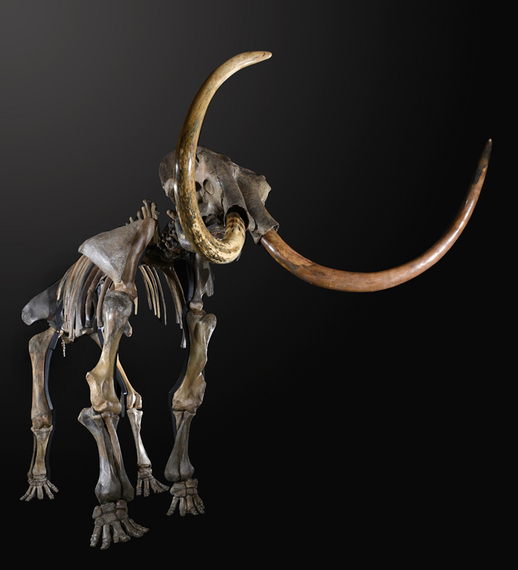On November 26 an auction house operating from a small village named Billingshurst in southern England will try to sell the entire fossilized skeleton of a Mammoth. Last year the same auction house -- an enterprise called Summers Place -- successfully sold a fossil Dinosaur -- (a Diplodocus) that had been found in Wyoming and somehow made its way to the same sleepy English village. How do I know this? Because on both occasions I was asked to help mount (if that is the correct word) these fossils -- to change them from being piles of disconnected bones into imposing structures conforming to their original gigantic shapes. Similar sales of prehistoric creatures happen from time to time at other auction premises, although usually in large cities like New York, London, Paris or Los Angeles rather than out-of-the-way villages in the heart of the English countryside.
And always such sales bring great howls and squeals of anguish from academics and museum curators. It is entirely wrong, they protest, for such things to fall into private hands and, even worse, that someone should have the temerity to actually make a profit from any transaction. They find it deplorable that various well-known movie stars, and other wealthy individuals, seek to acquire such things. This, they say, is an offense against science, and should be legislated against. Surely, they argue, fossils should be surrendered to museums where they would be freely available for the general public to view, wonder at and perhaps even learn from? Instead, their argument runs, they provide an undeserved income for mercenary collectors and dealers.
This glib response has a certain immediate appeal. Its altruistic ring seems to offer a vision of a new world order where everything is neatly stacked for the benefit of the whole of mankind. But it is actually a narrow, essentially destructive and mendacious view with a validity that can be torn apart on various grounds.
The first of these is the idea that museum acquisitions automatically go on display to the public. This notion is far from the truth. Usually (and for a variety of reasons, some good, some bad) they are deposited in basements from which they never emerge. They are likely to stay unprepared and remain in the blocks of stone that have housed them for millions of years. Museum workers usually lack the enterprise, the funds, the energy and the gallery space, to deal successfully with such pieces. So they stay in store. And if any member of the general public asks to see them, such a person can forget it!
Palaeontological academics have created a new priesthood in which they are the high priests and only accredited members of their arcane order are permitted to join the game. There are men and women who are exceptions to this generality, of course, but such people are in the minority. It is a great misconception to suppose that once museumed, fossils will be freely accessible to all.
And now for another misconception -- the one that suggests only qualified palaeontologists should be allowed to excavate and handle the material, and that private collectors and dealers should be excluded, even fiercely legislated against with new draconian codes. In some countries such Stalinism has already reached alarming heights! Not only is this kind of restriction a gross imposition on freedom, it is also a major barrier to the dissemination of knowledge. It is often the actual handling of -- not to mention the possession of -- such material that encourages and inspires children to learn.
There is one significant statistic that academics consistently, and conveniently, disregard. It is this: the vast majority of important fossil finds were actually made by amateurs, agents working for wealthy collectors or by dealers -- not by museum workers, despite the resources and influence they enjoy. It is a tradition that goes right back to the days of perhaps the most celebrated fossilist of all time, the famous Mary Anning, who (it could be argued) kick-started the whole science of palaeontology. And she was most certainly a dealer, not a university-trained academic.
There is an additional consideration to all of this: if fossils are not collected as they erode from cliffs, or weather from exposures of rock -- what happens to them? The answer is simple. Over a comparatively short period, they just rot away or are triturated into a million worthless pieces by the power of wind, ice or wave. Without private collectors and dealers, this is precisely what would happen to most of them. And in some parts of the world, the poor and under-privileged are able to scratch out livings by unearthing fossils and selling them, often uncovering the remains of creatures that would otherwise stay entirely unknown. Contrary to the idea fostered by the museum priesthood, these kind of discoveries have added enormously to knowledge of the prehistoric world.
Blinkered academics might also consider this: if a collector acquires an important fossil, either by personal discovery or through purchase -- what eventually happens to it? Often he or she, or those who come after, will gift it to a museum, a museum that then gets the item, with all the vital and costly preparatory work that has gone into it, entirely free of charge.
Sometimes, benefit comes even faster. It does not necessarily follow that an auctioned fossil will 'fall' into private hands. The publicity generated can create its own momentum, and generous benefactors will provide funding they would otherwise never have considered. The Diplodocus that Summers Place Auctions sold last year is a case in point. It was bought by the National Zoology Museum of Denmark and now stands in pride of place in that institution -- on display to the public, it might be added. Without a dealer having dug it from the ground and paid for its preparation and movement, without the publicity the auction house generated, there would have been no sponsorship, no acquisition and no dinosaur in Copenhagen.
